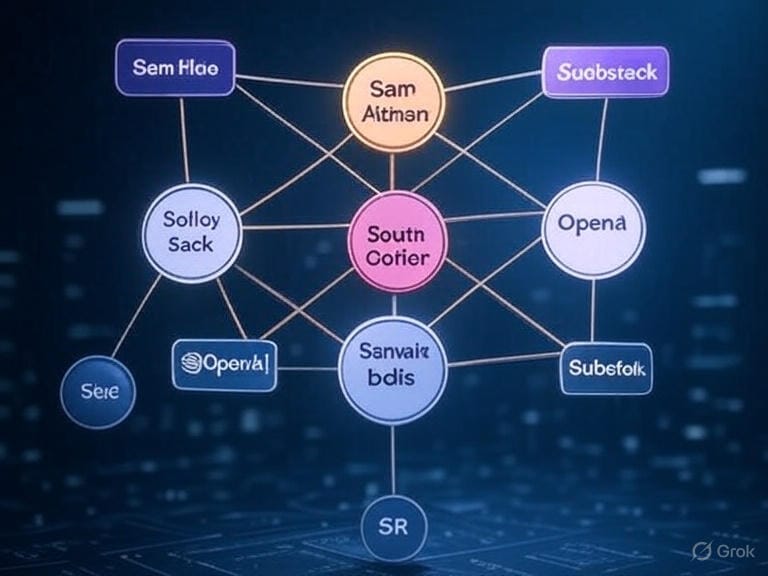The Interconnected Landscape:
Sam Altman, OpenAI, and Substack.com
Introduction
The interplay between Sam Altman, OpenAI, and Substack.com reflects a dynamic convergence of technology and independent publishing. It appears that Sam Altman’s influence on Substack is indirect, stemming from his leadership at Y Combinator during Substack’s formative years (2017–2018). OpenAI, under Altman’s leadership, engages directly with Substack through official publications and a technical integration of AI tools to enhance content creation. Additionally, Substack serves as a vibrant hub for independent discourse on OpenAI and AI, amplifying diverse perspectives.
AI and Independent Publishing
The digital era has fostered intersections between AI innovation and platforms like Substack.com, which empowers independent writers through a subscription-based newsletter model. Sam Altman, former President of Y Combinator (2014–2019) and current CEO of OpenAI, shapes both domains. OpenAI, a leader in AI research, drives advancements like ChatGPT, while Substack redefines publishing by enabling creators to connect directly with audiences. This article analyzes Altman’s indirect influence, OpenAI’s strategic engagement, and Substack’s role as an AI discourse hub, providing a clear, data-driven overview of their interconnections.
Section 1: Sam Altman’s Indirect Influence on Substack
Sam Altman’s impact on Substack is rooted in his role at Y Combinator (YC), not direct contributions.
Y Combinator’s Role in Substack’s Development
Substack, founded in 2017 by Chris Best, Hamish McKenzie, and Jairaj Sethi, joined YC’s Winter 2018 batch. During this period, Altman was YC’s President, overseeing strategic guidance for startups. Jared Friedman, Substack’s primary YC partner, provided direct mentorship, but Altman’s leadership shaped YC’s ecosystem, indirectly influencing Substack’s early strategy, funding (e.g., $2M seed round in 2018), and network access. This foundational support helped Substack scale to over 1 million paid subscriptions by 2023.
Altman’s Thought Leadership on Substack
While Altman does not publish on Substack, his ideas from YC’s “How to Start a Startup” lectures and productivity principles are widely discussed. Writers adapt his advice for Substack creators, as seen in posts like “How to Succeed With Your Substack (A Sam Altman Alteration)” (2024), which applies his fundraising strategies to newsletter growth. Discussions also cover his AI Startup School talks, reflecting his intellectual influence on Substack’s creator community.
Section 2: OpenAI’s Strategic Engagement with Substack
OpenAI directly engages Substack through official publications and AI tool integration.
Official OpenAI Publications
OpenAI operates two Substack newsletters: The Prompt: Insights from OpenAI Global Affairs (launched 2022), which clarifies AI’s societal impact for policymakers and the public, and ChatGPT for Education (launched 2023), offering resources for educators using Custom GPTs. These publications leverage Substack’s direct-to-audience model to control OpenAI’s narrative, bypassing traditional media.
AI Integration with Substack
In 2024, OpenAI introduced a “seamless integration” of its language models into Substack, enabling writers to use AI for drafting, editing, and optimizing content. This enhances creator efficiency and positions Substack as a tech-forward platform. However, Substack’s uncensored nature raises concerns about AI-generated misinformation, necessitating potential moderation policies.
Section 3: Substack as a Hub for AI Discourse
Substack hosts extensive independent commentary on OpenAI and AI, reflecting its role as a key platform for AI journalism.
Coverage of OpenAI and Sam Altman
AI-focused Substacks like Understanding AI by Timothy B. Lee and Import AI by Jack Clark frequently analyze OpenAI’s decisions, such as the 2023 board coup and ChatGPT Pro’s $200/month pricing. These discussions offer critical perspectives, contrasting with mainstream media’s broader narratives.
Substack’s Role in Independent AI Journalism
Substack’s open platform supports newsletters like The AI Break (daily) and AI Policy Bulletin (bi-weekly), covering technical, social, and policy aspects of AI. This diversity fosters nuanced debates about OpenAI’s influence, empowering experts and independent voices to shape AI narratives.
Consolidated Reference Table

The following table summarizes key connections between Sam Altman, OpenAI, and Substack, addressing the original article’s lack of a comprehensive reference.
| Entity | Type of Engagement | Details | Key Impact/Theme | Date (Approx.) | Source |
|---|---|---|---|---|---|
| Sam Altman | Indirect Influence (YC) | Leadership during Substack’s YC Winter 2018 batch | Shaped Substack’s early strategy and growth | 2017–2018 | YC records, Substack funding announcements |
| Sam Altman | Thought Leadership | Ideas from “How to Start a Startup” adapted in posts like “How to Succeed With Your Substack” | Influences Substack creators’ strategies | 2020–2024 | Substack posts (e.g., Za_Mad_Scientist, 2024) |
| OpenAI | Official Publication | The Prompt: Insights from OpenAI Global Affairs | Clarifies AI’s societal impact | 2022–present | OpenAI Substack |
| OpenAI | Official Publication | ChatGPT for Education | Provides educational AI resources | 2023–present | OpenAI Substack |
| OpenAI | Technical Integration | AI language model integration for content creation | Enhances creator efficiency, raises moderation concerns | 2024 | OpenAI announcement |
| Substack | AI Discourse | Newsletters like Understanding AI, Import AI | Critical analysis of OpenAI and AI trends | 2020–2025 | Substack publications |
Conclusion and Future Outlook
Sam Altman’s indirect influence through YC, OpenAI’s strategic publications and AI integration, and Substack’s role as an AI discourse hub highlight a symbiotic relationship. OpenAI benefits from direct communication and expanded AI tool adoption, while Substack gains advanced tools and credibility as an AI commentary platform. However, challenges like AI-generated misinformation require Substack to balance its uncensored ethos with responsible content oversight.
Looking ahead, Substack’s AI content will likely grow, driven by OpenAI’s tools and increasing creator adoption. This could create a feedback loop, with Substack data refining AI models and AI enhancing content creation, solidifying Substack’s role as a critical space for AI discourse.
